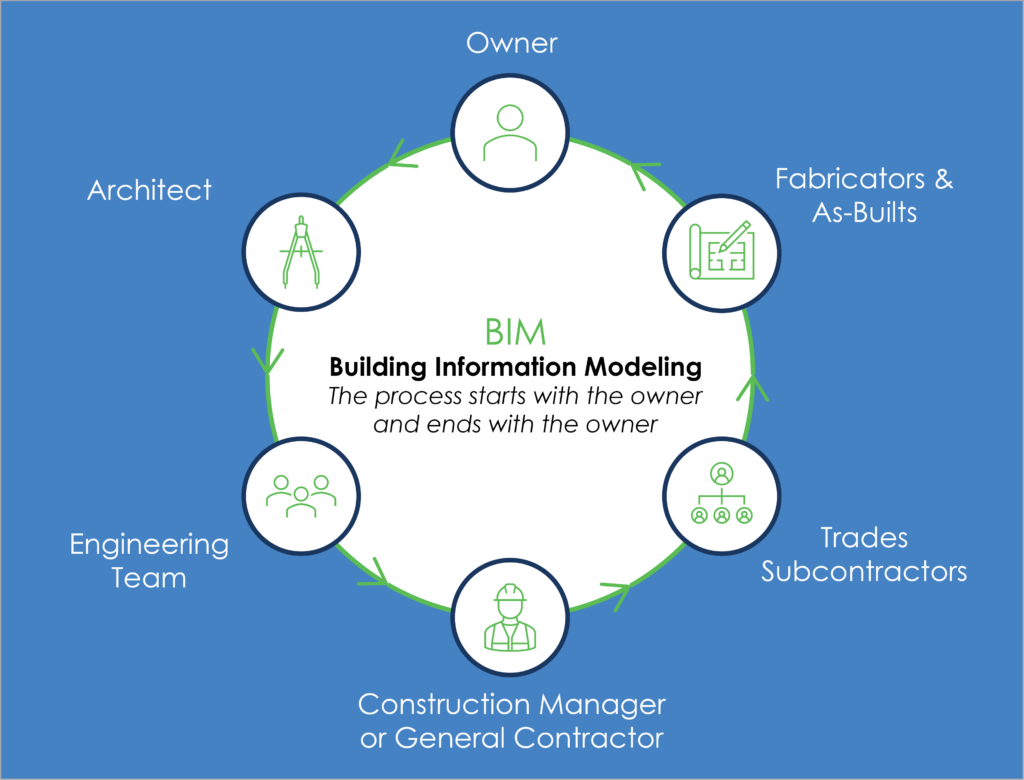Leveraging BIM for Stakeholder Collaboration

Project stakeholders understand that communication is key to a successful project and BIM as a toolset helps to align communication and collaboration among the building’s stakeholders.
BIM, when utilized to its fullest extent, is an incredibly useful tool, in every sense of the word. Wielded properly, it can save materials, energy, time, and money; however, if not maintained or used correctly, it will be a financial drain, dangerous to operations, and eventually become unusable.
Defining BIM by stakeholder needs
Owing to different budgets, needs, and expectations, what building owners and their users want out of a new building—and what they ultimately get—can be two very different things. Likewise, through experience, we’ve found that expectations differ depending on the stakeholders involved:
- Building Owner (Executive Team, Facilities Department, et al)
- Design Team (Building Owner Representatives, Architect, Engineers)
- General Contractor | Construction Manager
- Building Trades Contractors
- End User (Building Owner/Facilities Department)
To level expectations, help to have everybody on the same page at the beginning of a project, and to use BIM to its fullest extent, at Haley Ward, we have found it most useful to start with the project goals and work our way back. To put it more simply, start with the owner deliverables at the end of the project, and this will drive what is required to obtain the BIM objectives.
Having a BIM Execution Plan at the outset of the project is one of the best ways to have all stakeholders informed as to what the deliverables are. We have found that stakeholders have different requirements.
End user requirements
Building owners and facilities managers want to be able to walk away with a certain set of contracted deliverables at project completion.
These deliverables might consist of a fully engineered 3D BIM model used to design and construct the building, or manufacturer, warranty, and cost information for each component within the building’s 3D model, and integration with their Computerized Maintenance Management System (CMMS).
Contractor requirements
To install the physical items, the contractor team will need to know who is modeling the trades content in the model, whether the 3D model was used to create both installation and shop drawings, and whether a robotic total station has used coordinates from the model used in the field. There is a difference between a 3D model and a BIM, and the owner should decide what the difference is at the onset of a project.
General Contractor requirements
To maintain costs and manage expectations, GCs typically need to know whether the designs can be physically installed in the walls and above the ceilings.
They will also need enough time built into the schedule to adequately allow for installation discussion and modeling coordination.
Finally, the BIM will ideally capture the costs and experience associated with the project’s high-tech nature.
Design team requirements
The architects and engineers will need to know that the BIM program they are using is suitable to generate the BIM for release to the GC for use in their coordination/installation efforts.
Design team members will further want to coordinate their designs, and include complete component information, before handing the designs to the GC.
Finally, design team members will want to know who makes contract project changes to the model after it is handed to the General Contractor.
Building owner requirements
For a smoother process, an owner should be able to tell the design team what they truly want to accomplish. Our team can help communicate an owner’s goals with terminology that is consistent across the industry though we find it helpful for owners first to research what a BIM is to realize what they’re asking for. A BIM execution plan is a great way for this to be clearly communicated.
It is also important for building owners to realize that the project schedule will be different than what they’re traditionally accustomed to, and that the result will be a product that’s useful throughout the building’s life expectancy.
Because the model will provide large amounts of useful information, it’s imperative that the owner’s team know how to use it for the long-term. Part of this is budgeting appropriate in-house resources—including software, hardware, and training —needed to operate and maintain the BIM for the life of the building.
Bringing it all together
Getting your team to discuss all expectations and requirements will result in a common understanding of the delivered product. BIM is here to stay because it can save the building owner and their facilities departments installation materials, energy, time, and money throughout the course of the building’s life. Contact Director BIM Services, Dan Welch, if you would like to discuss the approach above or assistance with your next project.